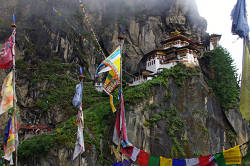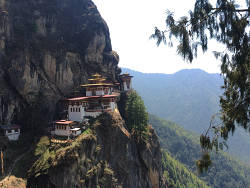Taktsang Dzong
Paro Taktsang - སྤ་གྲོ་སྟག་ཚང་ - Taktsang Monastery - The Tiger’s Nest
Useful Information

| Location: |
Paro Valley, Paro District.
3 h walk uphill, 4 km and 700 m elevation. (27.491911, 89.363489) |
| Open: |
Cave:
On special occasions. Monastery: All year daily 8-16. [2020] |
| Fee: |
Foreigners BTN 500, Students BTN 250. [2020] |
| Classification: |
 Cave Temple Cave Temple
|
| Light: | n/a |
| Dimension: | L=3,120 m. |
| Guided tours: | Guided tour for all foreigners. |
| Photography: | allowed |
| Accessibility: | no |
| Bibliography: | |
| Address: | |
| As far as we know this information was accurate when it was published (see years in brackets), but may have changed since then. Please check rates and details directly with the companies in question if you need more recent info. |
|
History
| 8th century | Rinpoche flew to the caves on the back of a tigress to meditate four months. |
| 1508 | first temple was built by the Nyingma Buddhist master Sonam Gyaltshen. |
| 1645 | site offered to Zhabdrung Ngawang Namgyel, the founder of Bhutan. |
| 1692-1694 | temple of the Eight Manifestations of the Guru erected. |
| 1861-65 | monastery extended. |
| 1961-1965 | renovated by the 34th Je Khenpo, Shedrup Yoezer. |
| 1982-83 | monastery extended. |
| 1992 | monastery extended. |
| 19-APR-1998 | monastery damaged by fire. |
| 2000 | footpath to the monastery built. |
| 2005 | footpath repaired. |
Description


The Taktshang Dzong (Tigress’s Lair Monastery) was built under an overhanging cliff 700 m above the Paro valley floor. Visitors must hike or ride a mule along steep and narrow paths to reach the monastery and temples. It is said some hikers have gone missing on the way up, probably lost their balance and slipped off the path. Obviously the almost vertical cliff is not for the faint hearted. One of the reasons why this is Bhutan’s most famous Buddhist monastery.
The monastery was according to legend the place where Padmasambhava, better known as Guru Rinpoche, reached Bhutan. The Indian sage brought Buddhism to Bhutan in the 8th century. He flew to this place on the back of a tigress from Singye Dzong, hence the name Tiger’s Lair. There are 13 caves in the cliff and Padmasambhava has meditated in the Taktsang Senge Samdup cave for four months. The monastery was built around the caves and consists of seven temples. Rinpoche lived in the 8th century, but the monastery is much younger, it was completed in 1692.
One legend tells that Padmasambhava tamed the Tiger demon to ride on its back. Another legend tells that a former wife of an emperor, known as Yeshe Tsogyal, willingly became a disciple of Padmasambhava in Tibet. She transformed herself into a tigress and carried the Guru on her back from Tibet to the Taktsang in Bhutan. Wherever the tigress came from, the Guru performed meditation and emerged in eight incarnated forms or manifestations and the place became holy.
The cave was used by many Tibetan saints for meditation. Langchen Pelkyi Singye came to the cave and it was named Pelkyi’s cave after him. Milarepa (1040–1123), Pha Dampa Sangye (died 1117), the Tibetan yogini Machig Labdrön (1055–1145) and Thangton Gyelpo (1385–1464). Lamas came from Tibet and established their monasteries in Bhutan.
The story how the monastery was built is almost as fantastic. Padmasambhava was reincarnated again in the form of Tenzin Rabgye. This was proven by the fact that he was once seen inside and outside his cave at the same time, he was able to feed all visitors with a small quantity of food, no one was injured during worship despite the steep paths, and the people of valley saw various animal forms and religious symbols in the sky.
Of the eight caves, four are comparatively easy to access. Tholu Phu is the cave where Padmasmabhava first entered, riding the Tiger. The cave where he resided and did meditation is known as the Pel Phuk. The main cave is entered through a narrow passage and houses a dozen images of Bodhisattvas. Butter lamps flicker in front of the idols. It also contains an image of Chenrezig (Avalokitesvara) and a small cell where the sacred scripture is placed. It was written with gold dust and the crushed bones of a divine Lama.
- See also
 Search DuckDuckGo for "Taktsang Dzong"
Search DuckDuckGo for "Taktsang Dzong" Google Earth Placemark
Google Earth Placemark Taktsang Dzong - Wikipedia (visited: 28-OCT-2010)
Taktsang Dzong - Wikipedia (visited: 28-OCT-2010) The Most Beautiful Yet Precariously Placed Monasteries on Earth (visited: 28-OCT-2010)
The Most Beautiful Yet Precariously Placed Monasteries on Earth (visited: 28-OCT-2010) Dark Roasted Blend: The Hanging Monasteries of the World (visited: 28-OCT-2010)
Dark Roasted Blend: The Hanging Monasteries of the World (visited: 28-OCT-2010) Tigers Cave | ZuZu Top (visited: 28-OCT-2010)
Tigers Cave | ZuZu Top (visited: 28-OCT-2010)
 Index
Index Topics
Topics Hierarchical
Hierarchical Countries
Countries Maps
Maps